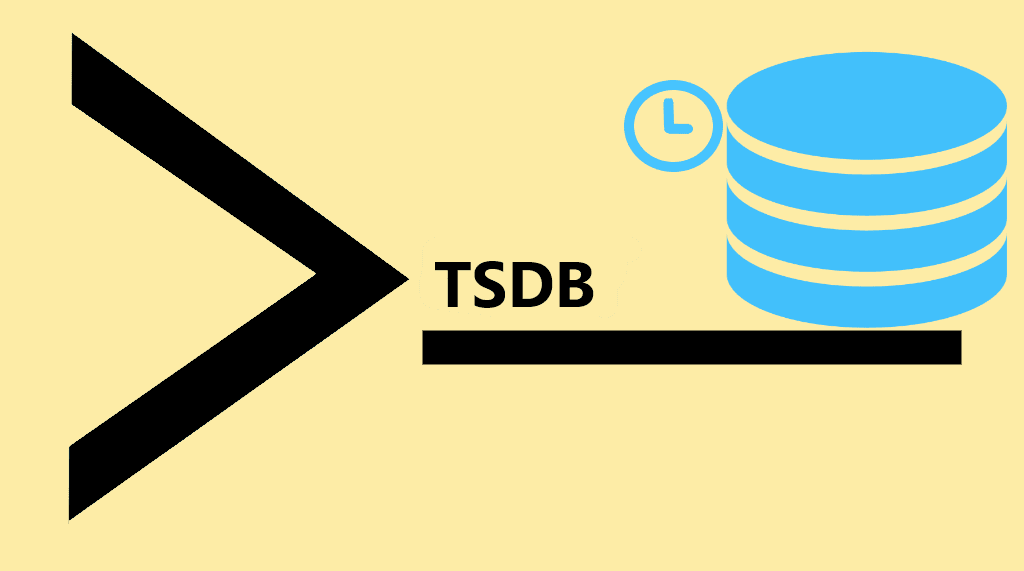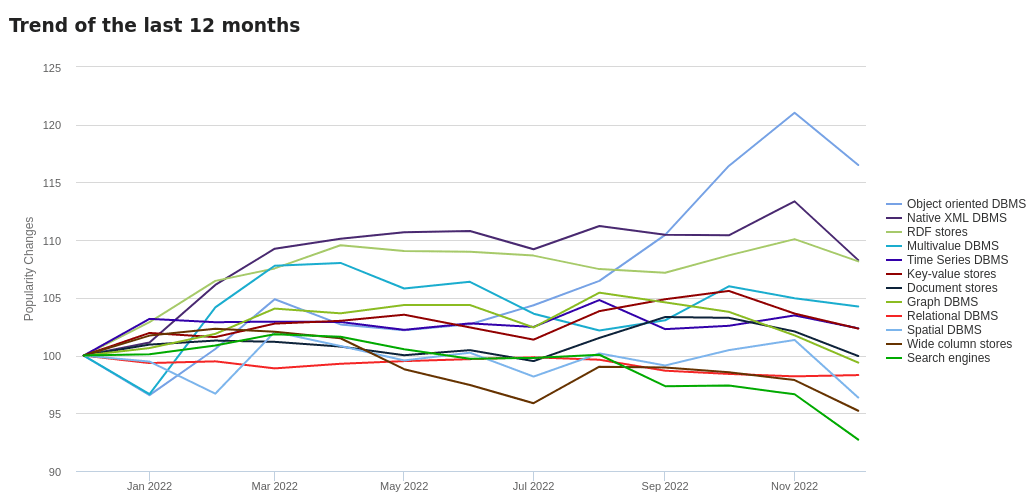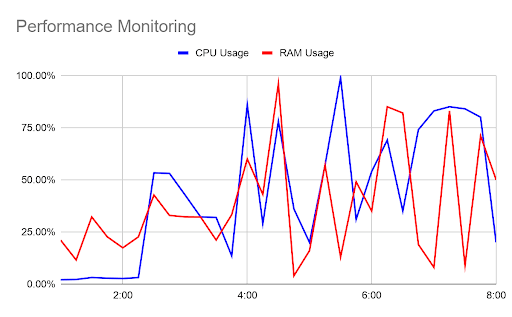What Is a Time Series Database? How It Works & Use Cases

As the Internet of Things expands quickly, many devices connect to the web and transmit time series data. As a result, industries are interested in creating time series databases with unique management and analytical features.
Time series data is frequently used to estimate future trends, find insights into processes, and issue alerts based on real-time analysis. We shall examine the time series database, its function, and how it affects our daily life in more detail in this post.
What Is a Database?
A database is a systematic data collection that is organized and kept on an electronic device. For example, a contact list is a physical database where one writes down names, residential addresses, phone numbers, and email addresses. It creates profiles by storing correlated information about individuals.
Over time, databases have undergone significant changes. As a result, there are different databases and several data types a database can handle, depending on its structure or management system.
What Is a Time Series Database?
A time series database (TSDB) is a database management system developed primarily to handle, store, and analyze time series data that fluctuates over time. Data on a system's current state, trends, and past patterns is easily retrievable with such a system. A TSDB can also manage concurrent inputs, allowing us to simultaneously store and process numerous data streams and aiding in integrated analysis.
The following graph displays the popularity trends of several systems.

What Are the Characteristics of Time Series Data?
Compared to other datasets, time series datasets are uniformly massive and sizable. Both data generated at predictable intervals and data generated at regular intervals are available for inclusion in time-stamped data. In many fields, time series data has become a crucial element of data analysis.
The following are the primary traits of time series data:
- Time-stamp: Time series data can be indexed using timestamps; the timestamp linked to each data item serves as the computation's primary input.
- Structured data.
- Stream-like environment: Time series data from linked devices can be compared to a data stream because it is continuously gathered and enters the database, maintaining a flow.
- Stability: The overall traffic will remain stable in a time series scenario.
- Elevated write/read ratio.
- Instantaneous computing.
How Does a Time Series Database Work?
Time series databases record both static and dynamic values. For instance, most server monitoring applications that examine CPU performance, disk utilization, and memory usage use TSDBs. As a result, you can dig down to a specific time interval with real-time monitoring of these data to learn more about the problem and take proactive action.
The graph below shows the relationship between CPU and RAM consumption over time on a particular server. This information can be efficiently stored and used to make a projection based on previous data.

A time series is a collection of data points made up of a series of measurements taken over some time. Each point in a time series consists of a timestamp and a numerical value. Each metric is stored as a separate time series in a time series database, enabling you to query and graph the values across time.
The ideal format for storing time series records in a repository allows for rapid time-based writes and reads. Furthermore, the sequence of the data points becomes a natural property of the data because the records are time-stamped. The data can then be delivered to a stream processing engine using this order, which will consider the ordered data like a data stream.
Benefits of Time Series Databases
Here are some of the advantages of time series databases.
High-Performance Analytics Support
They offer the storage organization and logic required by high-end applications.
Scalability and Volume
Time series data accumulates quickly, and these databases are designed to give enormous scale. As a result, you can monitor a vast volume of real-time data with almost instantaneous speed and storage effectiveness. For industrial uses, this approach looks appealing.
Accuracy
They depict time-based information and offer more precise measures of change over time.
High Degree of Efficiency
These databases are set up to send data to various processing engines effectively, imitating the actual data stream.
Applications and Example Use Cases of Time Series Databases
Some of the applications of a time series database include:
Software Systems Monitoring
(virtual machines, containers, services, and applications)
Time series data analysis has increased in popularity and importance for corporate operations. It is used to monitor software systems. For example, if you utilize an application, you can change a user's last login timestamp each time they log in. Capturing data as a time series allows observation of past login activity, usage trends over time, grouping users based on app usage frequency, and more.
Physical System Monitoring
(equipment, machinery, connected devices)
Self-driving cars continuously gather data about how their surroundings change, making adjustments in response to the weather, potholes, and other factors.
Additionally, our smart houses monitor what happens inside to control the temperature, detect intruders, and provide additional safeguards.
Asset Tracking Applications
(vehicles, trucks, actual containers, pallets)
Our retail sector uses time series data to precisely and effectively track the movement of its assets.
Financial Trading Systems
(classic securities, newer cryptocurrencies)
Stock traders also use time series analysis to comprehend the trends in different stock prices better. Financial forecasting also benefits from time series data, which you can cross-check for analysis.
Eventing Applications
(monitoring user/customer interaction data)
Some online publications use this data to track subscriber information, trends, etc.
Business Intelligence Tools
(tracking key metrics and the overall health of the business):
Financial analysts also utilize time series data to evaluate growth, such as changes in stock prices or a company's production over time. If a company needs to monitor data in real time and use it in their application performance monitoring software, they may use a time series database.
Disadvantages of Time Series Databases
1) Compared to relational or NoSQL databases, time series databases are more difficult to set up and maintain.
2) There are fewer time series databases to pick from, which limits your options for finding a platform that satisfies your particular requirements.
3) Time series analysis provides a probability value on potential future outcomes rather than the actual project value.
Popular TSDB systems
InfluxDB
InfluxDB is an open-source, high-speed read-and-write time series database (TSDB) created by InfluxData. They offer data in a time series format with excellent availability & efficiency.
Prometheus
Prometheus is a leading open-source metric monitoring tool and an open source TSDB. Prometheus gathers and saves metrics as time series data, which means that metrics data is kept along with the timestamp at which it was recorded and optional key-value pairs called labels.
KDB
KDB+ is a KX-created and -marketed in-memory column-based relational time series database. Financial organizations frequently employ databases to quickly store, analyze, analyze, and retrieve massive amounts of data.
Graphite
Graphite is a free, open-source software tool for tracking and displaying numeric time series data, such as computer system performance. Orbitz Worldwide, Inc developed graphite.
RRDTool
RRDTool is an open source, high-performance data logging and graphing system for time series data. It seeks to manage time series data like network bandwidth, temperatures, or CPU load.
OpenTSDB
OpenTSDB is a distributed time series database built on top of HBase and is scalable. It performs both reading and writing tasks very well. Without compromising granularity, it can store and provide enormous amounts of time series data.
DolphinDB
DolphinDB is an easy-to-use, fully featured, high-performance programming language and time series database. It is incorporated with a high-volume, high-velocity streaming analytics system, delivering concurrency, fault tolerance, scalability, and operational simplicity.
TDengine
TDengine is a high-performance time series database that is open source and designed for the Internet of Things (IoT), connected cars, industrial IoT, etc. As a result, time series data processing can be made more accessible with TDengine.
QuestDB
QuestDB is an open-source SQL database that was created with the goal of processing time series data quickly and simply. QuestDB is a good choice for monitoring infrastructure, real-time analytics, dashboards, sensor data, application metrics, and financial market data.
VictoriaMetrics
VictoriaMetrics is a time series database and monitoring system that is quick, affordable, and scalable. It is used for the long-term archiving and processing of large volumes of data.
Amazon Timestream
Amazon Timestream is a serverless time series database used to monitor vital business applications and gain real-time insights.
Do Time Series Databases Need Specialized Databases?
There is always a need for quickly and efficiently storing and processing large amounts of data. Specialized time series databases handle the data influx by focusing on time. Each row includes a time entry, and analyzing data along this dimension helps users identify how systems change over time.
Since time series data generates unprecedentedly, scalability and volume are essential for these databases. You need specialized databases for time series data because:
- In time series data samples, millions of data points generate every second, necessitating real-time analysis. Unfortunately, relational databases are not compatible with handling this quantity of data.
- It would take days for a basic database to compute the average response time of a time series database, and at times the overall conclusion may have accuracy problems.
- Because relational and NoSQL databases cannot compress the enormous data influx effectively, storage costs can increase.
Alternatives to Time Series Databases
Different databases are for various purposes. The most popular type of database is a relational database. However, since they take longer to insert and retrieve time series data, relational databases are not ideal for managing them.
Also, NoSQL databases are a superior choice over time series databases, depending on your workload. The existence or absence of schema is one of the critical distinctions between SQL and NoSQL. Most NoSQL databases are scalable and have dynamic schemas. Therefore, these databases are an excellent substitute for time series data storage if these factors are essential.
Conclusion
The demand for systems that can store and handle massive volumes of data rapidly and effectively has expanded due to the market's expansion. As a result, time series databases have established value in various fields, including supply chain management, e-commerce, and advertising. If your company or application works with time series data, you require a dedicated time series database. The benefits of employing such a database are too significant to overlook, and the drawbacks of using an outdated, less capable database are increasingly evident.
If scalability and performance are critical to your business, consider Liquid Web’s VMware Private Cloud. The dedicated infrastructure allows you to build your cloud environment to handle most enterprise workloads. Contact our sales team today for a consultation.
FAQ
Which time series database is the best?
What distinguishes the InfluxDB time series database?
Is InfluxDB open source?
Is a time series database better than a relational database for handling time series data?
Related Articles:

About the Author: Sapta Upendran
Sapta is a passionate Linux system engineer, a voracious reader, a dexterous cook, and a wanderlust. She is also interested in technical and non-technical writing.
Our Sales and Support teams are available 24 hours by phone or e-mail to assist.
Latest Articles
In-place CentOS 7 upgrades
Read ArticleHow to use kill commands in Linux
Read ArticleChange cPanel password from WebHost Manager (WHM)
Read ArticleChange cPanel password from WebHost Manager (WHM)
Read ArticleChange the root password in WebHost Manager (WHM)
Read Article


